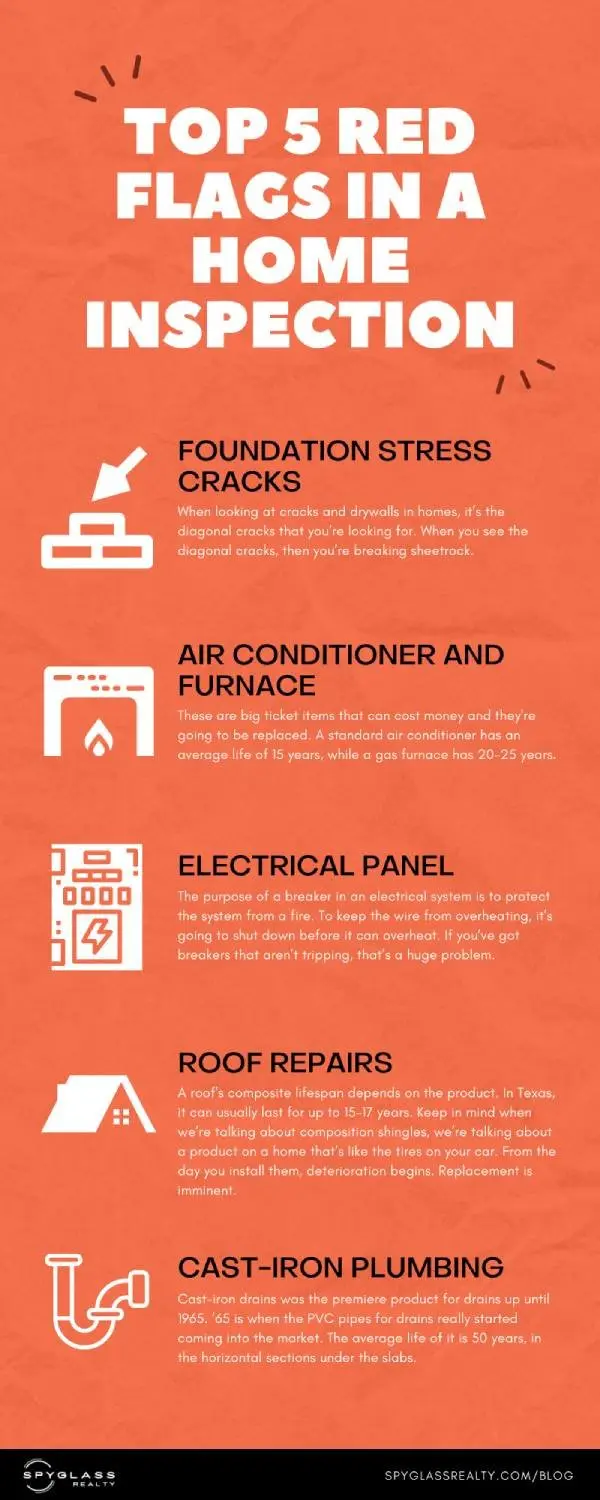We sat down with Chris Nowling, a Certified, Master Home Inspector and Owner of CNI Services - Texas Home Inspection. Chris has completed over 12,000 home inspections within his 30+ years of professional home inspection. In this blog, we'll be breaking down to you the common Top 5 Red Flags in a Home Inspection.
1. Foundation Stress Cracks
Cracks in sheetrock inside a home can result from various causes, including foundation movement, shrinkage, or past moisture conditions. Determining what constitutes "normal" settlement can be elusive, as engineers avoid defining it precisely. When inspecting cracks in drywall, vertical or horizontal lines usually indicate minor issues like shrinkage. However, diagonal cracks, especially those originating from doors or windows, signify significant sheetrock damage due to forceful activity.
Understanding a home's typical lifespan is crucial. In regions with expansive soils, early signs of activity may appear within a year. Neglected maintenance exacerbates these issues, emphasizing the importance of proper drainage.
For homeowners, avoiding actions that impede drainage, such as building raised flowerbeds against the house, is essential. Uneven watering can lead to soil swelling, creating stress on the foundation and potential damage. Therefore, ensuring proper water flow away from the house is critical for preserving its integrity.
2. Air Conditioner and Furnace Age
Big ticket items like furnaces and air conditioning systems inevitably deteriorate from the moment they're put into service. It's crucial to know their age because the day will come when they need replacement. Many manufacturers now make it easy to determine the year of manufacture by looking at the equipment's plate. However, some conceal this information within their serial numbers, though online resources can often help decipher them.
The expected lifespan of furnaces varies depending on type. In homes with natural gas, typically, a gas furnace lasts around 20-25 years, while the standard air conditioning system lasts about 15 years. However, in regions like ours, where heat pumps are common due to their energy efficiency, the lifespan is shorter, averaging around 10-12 years. Heat pumps, being all-electric, run year-round, increasing the likelihood of failure or breakdown compared to systems that are used only seasonally.
3. Electrical Panel
Federal Pacific Electric, particularly known for its Stab-Lok electrical panels, was a prominent manufacturer for several decades, primarily from the 1960s to the late 1980s. However, issues arose with their Stab-Lok panels, as the breakers often failed to trip when necessary. Breakers are crucial in preventing overheating and fires by shutting down the system before such dangers occur. Therefore, the failure of breakers to trip poses a significant risk.
While Federal Pacific has been flagged for this issue, it's not unique to them. Other manufacturers have faced similar problems, with some even embroiled in litigation since the early 1980s due to product issues that persist to this day. Attempts to remanufacture the breakers have been unsuccessful, leaving homeowners uncertain about their breaker's reliability. Testing is one option, but once a breaker is tested, it cannot be reinstalled, leading to a cycle of uncertainty.
Sign Up for free Get the first to receive the latest listing updates, save favorites & much more by signing up.
If you already have in account, SIGN IN.
4. Roof Repairs
From the ground, assessing the condition of roof shingles, especially composition shingles, can be misleading. What appears fine from below may reveal issues when inspected from the top. Granule loss is a common concern with composition shingles, akin to tire tread on a car, as deterioration begins immediately upon installation.
Inspectors often need to identify leaks and gauge the remaining lifespan of the shingles. However, while functionality is crucial for inspectors, insurance carriers may have different criteria for insurability.
The lifespan of composite shingles varies by type. Three-tab shingles, the most common, are typically rated for 20 years by manufacturers, but in our region, 15 to 17 years is considered good. Metal roofing has gained popularity, offering options ranging from affordable to high-end, with some lasting a lifetime and withstanding hail damage without issue.
5. Cast-Iron Plumbing
Before 1965, cast-iron drains were standard, but PVC pipes gained popularity around then, especially in middle and lower-end homes. Upper-end homes stuck with cast iron until the early 1970s, favoring its perceived durability. However, the shift to slab foundations highlighted an issue: cast-iron drains weren't suitable for these structures, leading to inevitable failures. With most homes in Austin built on slabs since the 1960s, many now face the costly and labor-intensive task of replacing these failing drains.
Replacement methods vary, from lifting floors to tunneling under foundations, each with its challenges and costs. This process can easily set homeowners back $25,000 to $30,000 for an average-sized house, creating a significant financial burden for those affected.
Watch the Full Interview with Chris Nowling below.

Posted by Ryan Rodenbeck on

Leave A Comment